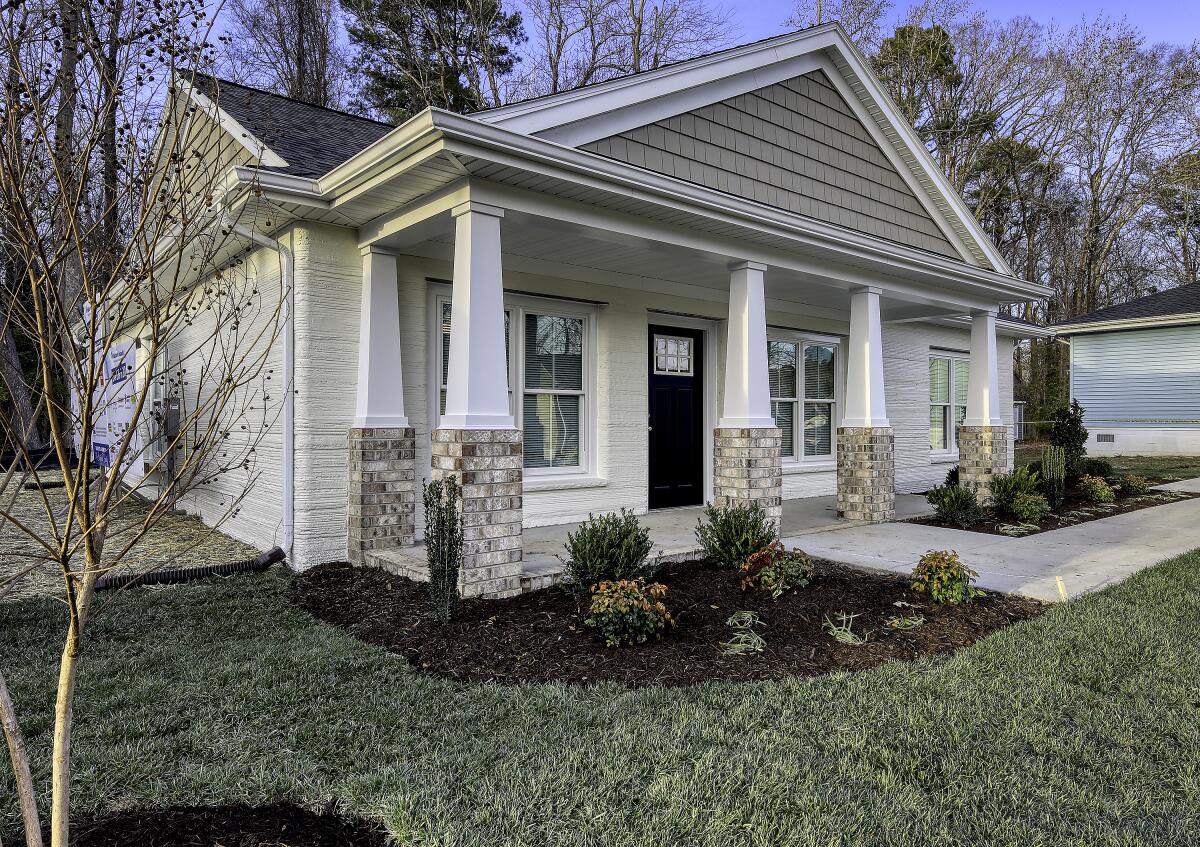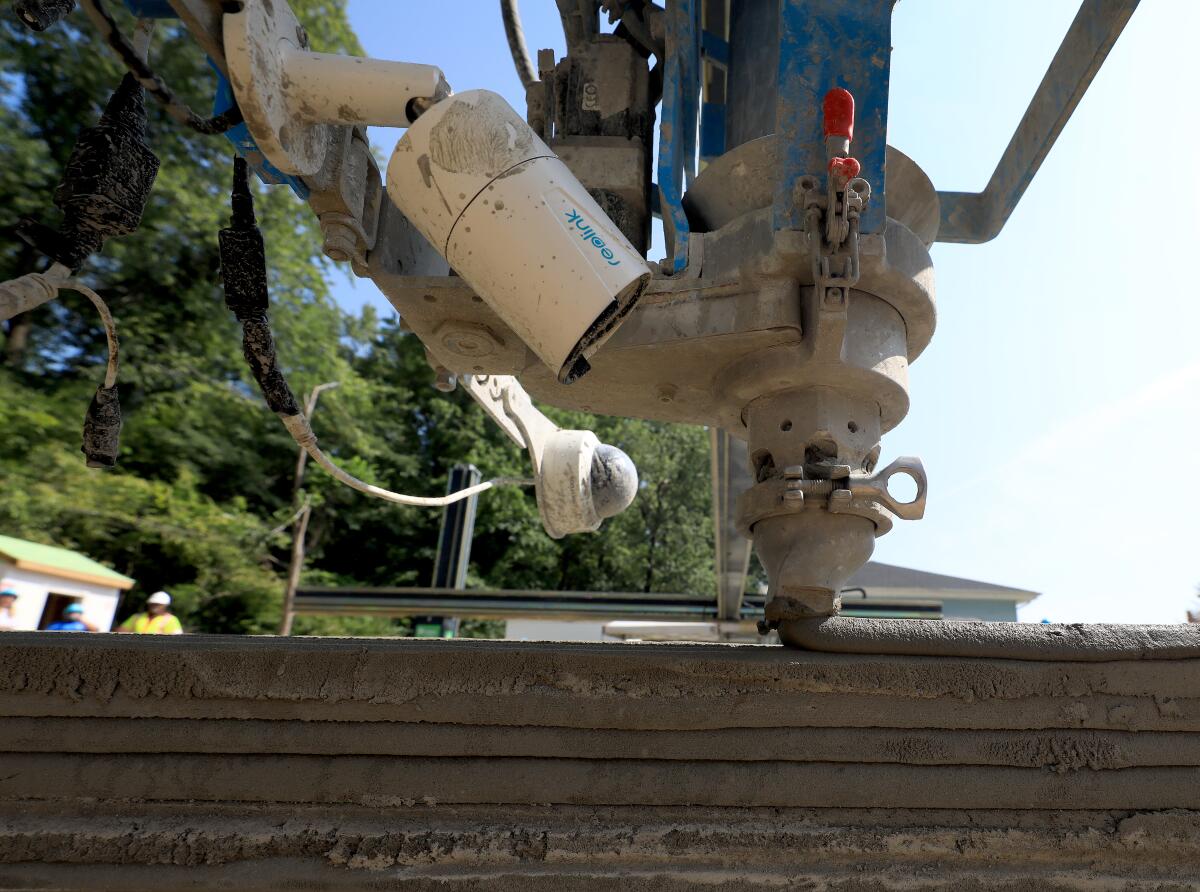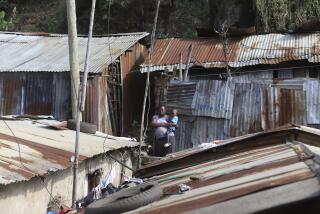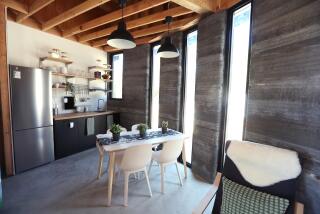Technology helps offer 3D-printed homes as an option for ownership

- Share via
OCALA, Fla. — For Apis Cor, a construction company based in Melbourne, Fla., building certain kinds of homes relies an awful lot on a key team member named Frank.
Frank has an arm that reaches more than 16 feet, said Anna Cheniuntai, the company’s founder and chief executive, and can follow a computerized design blueprint while pushing out a steady stream of beaded construction material used to make walls.
Frank, you see, is a large, mechanical component of the technology used to build 3D-printed homes.
Proponents of the technology in recent years have pointed to 3D-printed homes as an innovative step toward addressing housing needs in the United States and elsewhere. Several projects are underway as communities cope with housing shortages and experiment with options.
The nonprofit housing organization Habitat for Humanity unveiled its first 3D-printed home in December in Williamsburg, Va., and is due to unveil another in Tempe, Ariz., in February.
“We’re at the very beginning of 3D printing,” said Janet V. Green, CEO of Habitat for Humanity Peninsula and Greater Williamsburg in Virginia. “I hope that this does help some of the affordable housing crisis that we have across the nation.”
Other examples exist inside and outside the U.S. In northern Italy, 3D-printed dome-shaped houses were made out of raw materials, such as clay. And in Dubai in the United Arab Emirates, the Dubai Municipality, a government building, stands as the largest 3D-printed structure in the world.
Here’s some of what several construction business officials and observers described as key points to know about 3D-printed housing:
Homes built with 3D-printed technology use large-scale equipment for much of the construction, but also rely on traditional techniques for other basic needs of a home, such as roofing, electrical wiring, insulation and window installation.
Andrew McCoy, professor and director of the Virginia Center for Housing Research at Virginia Tech, said a general idea of what to expect in the U.S. would be a 1,600-square-foot, three-bedroom, two-bathroom, 3D-printed home that sells for about $264,000 to $330,000. As with any home construction, factors such as the region where the home is built, floor plan design, number of stories, textures and finishes can change the price of the home.
In September, researchers at the Federal Home Loan Mortgage Corp., also known as Freddie Mac, estimated the current shortage of available homes in the United States to be close to 3.8 million.
Here are examples of 3D-printed home projects underway in different parts of the country:
In Palm Springs, the Oakland-based construction company Mighty Buildings is working on a 3D-printed community of 15 homes in the Coachella Valley.
In Austin, Texas, a development of more than 500 homes is underway by the Icon Co. The company had already broken ground in 2020 on a 51-acre development called Community First! Village that is expected to provide 3D-printed housing to approximately 480 homeless people when complete.
Fabian Meyer-Broetz, head of 3D construction for Houston-based construction company Peri, said his company expects to complete construction on a 3D-printed home for Habitat for Humanity in Tempe by mid-February. Peri officials said the company’s 3D-printed projects included an apartment building in Beckum, Germany.
Peri, like several construction firms, hopes to make housing more affordable and viable to a broader range of people, Meyer-Broetz said.
Cheniuntai of Apis Cor said one of her company’s overall missions is to complete construction on a $336,000, 1,700-square-foot, two-bedroom, two-bathroom house and make it move-in ready in just seven days. Apis Cor has received 25 reservations for 3D-printed homes, mainly in Florida, which are scheduled to begin construction in 2023.
“Today, the average time for a wood stick house is at least seven months,” Cheniuntai said. “So with the technology that we have, we can build a house in up to two or three months.”
How might 3D-printed homes perform against Mother Nature?
A study conducted by Pew Research in 2020 showed that 63% of Americans live in communities directly impacted by climate change, and that number is expected to increase. The National Oceanic and Atmospheric Administration estimated that $145 billion worth of houses and infrastructure were lost or damaged in wildfires, tornadoes, hurricanes and other climate-related disasters in 2021.
“By far, weather is your biggest problem variable,” said Zach Mannheimer, CEO of Alquist 3D, an Iowa City-based construction company specializing in 3D-printed buildings.
Mannheimer said that because 3D-printed homes rely on concrete, they’re resistant to threats such as hurricanes, tornadoes and wildfires.

Alquist 3D was the construction company behind the 3D-printed Habitat for Humanity home in Williamsburg, Va. The company had built a model home in Richmond before breaking ground on the Habitat home a few months later.
What are some concerns tied to 3D-printed homes?
Although concrete is versatile and has high durability compared with other construction materials such as wood, it has a nasty carbon footprint, emitting lots of greenhouse gases and making it the third largest source of industrial pollution, according to the Environmental Protection Agency.
McCoy of Virginia Tech said some efforts exist and others are underway in the construction industry to develop options that reduce such environmental damage and create “a better footprint.”
Some builders and contractors worry that some jobs traditionally done by people are being handled with the new technology, Mannheimer said.
The U.S., however, is facing a soaring demand for construction workers, with an estimated 345,000 open jobs in construction unfilled, according to a November 2021 study by the U.S. Bureau of Labor Statistics. A survey conducted by the Associated General Contractors of America in September 2021 found that many contractors and firms are struggling to find qualified workers to fill open positions for builders and inspectors.
Some analysts said it’s too soon to tell whether 3D-printed homes will hold up to traditional construction in the long run. Even some of those people in favor of using the technology said they can understand why potential homeowners might tread lightly when considering a 3D-printed home.
“For some homeowners, buying a home might be the biggest investment they’ll ever do,” Meyer-Broetz said.
Timothy Turcich, who lives in Orlando, has reserved a 3D-printed home with Apis Cor. He said he read the news over the holidays about the 3D-printed home that was built in Williamsburg. The next week, he was on the phone with Apis Cor to submit a deposit for a reservation.
“When I first started saying I wanted to build something, it was a fringe idea of mine, but I actually feel like it’s less fringe,” Turcich said. “This offers the lightest friction to building a house that I’ve seen.”
More to Read
Sign up for Essential California
The most important California stories and recommendations in your inbox every morning.
You may occasionally receive promotional content from the Los Angeles Times.











